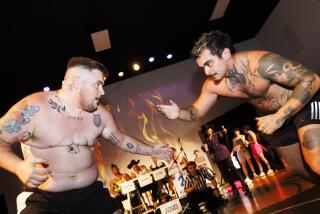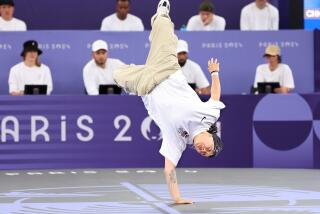Art for Art’s Sake : Taekwondo Tournament Gives Adherents Chance to Show Why Sport Is So Popular
- Share via
When 4-year-old Dale Cooper kicks and shrieks, he looks just like the older kids. But something is different.
This young taekwondo student is more interested in locating his parents than in maintaining 2,000 years of martial arts tradition.
It’s a tradition to which Master Sang K. Sa, a former world champion, has devoted his life. Sang, who began when he was Cooper’s age, teaches at a taekwondo school in the Wilshire District on 6th Street and recently directed a daylong tournament for fighters of all ages at Los Angeles High.
He said it is common to see youngsters of 4 or 5 fall on their faces.
“To people watching them they seem awkward and cute,” Sang said. “But to (the young martial artists), it’s truly very serious.”
Taekwondo will be a demonstration sport at the 1992 Summer Olympics in Barcelona and many of the tournament participants hope to compete in future Olympics. Thus, it is serious business to the athletes.
A taekwondo tournament such as this has more than 250 competitors of all ages and degrees of skill. The events are broken into two main parts, the form competition and the sparring.
In the form portion, there may be three participants displaying their taekwondo techniques simultaneously in each of eight marked-off areas.
Arms and legs flail and kick in a dance-like display that lasts about two minutes. From the oldest martial artist, 69-year-old Julio Gillen, to Cooper, form displays are accompanied by serious faces, grunts and growls.
When the sparring begins, the noise level goes up a few notches as yellow belts, green belts and others battle in the ultimate display of their techniques--hand-to-hand competition.
In taekwondo, as in judo, levels of achievement are designated by colored belts, beginning with white and advancing through yellow, orange, purple, green, blue, brown, red and finally black. And once a student has reached black-belt designation, there are degrees. Sang, for instance, is a seventh-degree black belt.
Taekwondo literally means the art of hand and foot fighting.
Victor Ramos, a student of Sang’s, said that taekwondo differs from other martial arts in that more emphasis is put on kicking than punching.
“You can punch, but it has to be a very solid punch to the chest only,” he said. “Not the head.”
For three hours the fighters compete, the list of winners dwindling. In the final phase of the sparring portion, the fighting is furious and quick, and there are accidental but inevitable injuries.
One fighter, Sherry King of Bakersfield, suffered a dislocated shoulder while sparring in the yellow-belt division. After her shoulder was popped in again, she was given the decision based on her performance before her injury.
King predicted that her injury would not keep her from fighting again.
“I’ve been doing it for a year and its been real great for me,” she said. “I quit smoking and I stay in great shape.”
Finally, after hundreds of bouts, the battles for the grand-master championship are at hand.
In the grand-master championship round, the winners of all the weight classes compete against each other. The grand-master championship in this tournament was won by Brazilian Wilson Lopes, who bears a strong resemblance to “Karate Kid” actor Ralph Macchio.
Although the tournament lasted nearly 12 hours, many of the spectators and fighters stayed until the final bout between Lopes and Hyon Lee of Downey. Lee, who had suffered a foot injury three matches earlier, could barely stand the pain while it was being re-wrapped before the final bout but was still able to fight.
That, said Ramos, typified the spirit of taekwondo.
Many martial artists view taekwondo as a spiritual experience as well as a sport. Sang said that it is important not only to know the sport but the “Oriental philosophy that comes from it.”
In the last 15 years, dozens of taekwondo schools have opened in Southern California, although it is growing in popularity elsewhere as well.
“It is the fastest growing martial art in the world,” Sang said.
More to Read
Go beyond the scoreboard
Get the latest on L.A.'s teams in the daily Sports Report newsletter.
You may occasionally receive promotional content from the Los Angeles Times.










